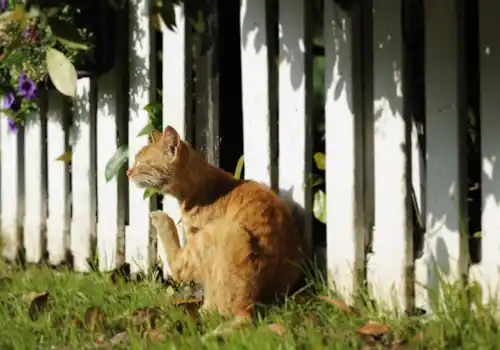While you might be seeing your cats playing together seemingly happily, all may not be well, unless you know what to look for, as Clare Hemington explains.
‘Watching two cats play, all might not be what it seems …’
Clare Hemington
This is my first attempt at creating a quote, and while it might not be very profound it does hopefully convey the message that we should be careful when interpreting our cats’ behaviour, and nowhere is this more relevant than when cats ‘play’ with each other.
Of course, there’s nothing nicer than seeing bonded cats interacting, whether it be sleeping wrapped around each other, grooming each other, or hurtling around the house in a lovely game of chase. But what might appear like harmless fun between two consenting cats engaged in a bit of rough and tumble can in reality be them fighting for their lives.
But before we try to figure out what’s play and what isn’t, let’s go back to kittenhood when play behaviour in cats first makes an appearance.
How play develops in kittens
Play behaviour starts to develop when kittens are between two and three weeks old. Initially it is used as an important part of their social contact with their littermates and mother. I suspect that those of you lucky enough to have been a kitten parent will have enjoyed spending hours watching them ambush, chase, sneak, swat, and pounce on each other, while everything else that you should actually have been doing gets abandoned. But while this appears all very cute to us, it is an incredibly important experience for kittens as this is when they learn how to communicate and interpret the body language of their feline littermates. For example, they learn that if they bite too hard, there is likely to be harsh consequences dished out by the bitten sibling and this should eventually teach them not to repeat the behaviour, a practice that will stand them in good stead in the future.
All this learning means that when cats become adults they should already understand what the rules of engagement are when they interact with each other.
What is play and what isn’t?
I did say ‘should’. It would be lovely if whenever cats meet, they politely greet each other or simply indulge in some good-humoured wrestling. And while this may happen in some instances, in others, such as when cats that don’t actually like each other interact, you might wonder if playtime has crossed over into aggression, especially when the behaviours involved such as chasing, pouncing, grabbing, and kicking appear so similar. This can be even more of a conundrum if you are a new cat parent and have difficulty interpreting cat behaviour or if the cats are new to each other. So how exactly do you know when your cats are playing and when they’re involved in a confrontation?
Understanding your cats’ body language and vocalisations is key in helping you determine whether your cats are fighting or having fun. When you see your cats engaging in what you believe to be play, look closely at their body language and listen to their vocalisations.
Play — cat play usually involves chasing each other, rolling around, and batting each other with their paws. Their bodies are relaxed, their ears will be in an upright or forward position, and their fur will be flat against their bodies, as it normally is. When they’re playing their claws will usually be retracted and can’t be seen. Any biting will be gentle. During wrestling and chasing, your cats will change roles frequently. This means they will take turns in being the cat that’s chasing and being chased and the cat that’s on top or pinned underneath. In this respect, the play is reciprocal. The cats might even take brief breaks from the play to rest.
As for vocalisation, playful encounters are generally silent and you should hear no hissing or growling.
Non-Play — when cats are being actively aggressive with each other they will hiss, swipe with their paws, and chase one another. Their bodies will lean away from each other and their ears will be rotated backwards and flattened on their heads. In an attempt to make themselves look bigger in the eyes of their foe, the fur on their bodies and tail will stand up straight. Their claws will be out and visible and any biting will not be inhibited, something you will only know about if one or other of the cats yelps out in pain.
One cat will be the instigator and the other the victim. This means that you will usually only see the same cat being chased and pinned down. Chasing a tired cat until it hides is also a tell-tale sign of conflict and obviously any injury that is inflicted is another indication things have gone too far.
There will be active vocalisation such as growling, a yelp in response to a bite, or hissing to tell a combatant that he should retreat. All these are signs that your cats feel threatened and aren't having fun. I always ask owners to try to video interactions between cats to help me determine whether it’s a social or combative encounter, and to demonstrate that there could in fact be a very real problem between the cats.
Tension is rising
Another way to determine whether your cats are playing or fighting is to remember that adult cats only play in social contexts. So, in order for the behaviour to be classed as play, the feline parties have to have a social relationship.
To understand this, you can observe how your cats act around each other when they’re not playing. Are they showing friendly behaviour and relaxed body language? Do they groom each other, sleep in physical contact with each other, and generally live peacefully together? If so, they are likely to share a bond and what looks like playing will be just that.
However, if your cats have a hostile relationship, are normally tense in each other’s presence, avoid each other, hiss and growl if they accidentally touch each other, or if one comes too near, they will view each other as opponents, then any wrestling and rolling probably isn’t friendly. It’s more likely to be fighting either in competition for resources or territory, bullying, or simply as a result of being fearful of each other.
Sadly, in such cases you might start noticing other behaviours occurring in one or both cats which result from the stress associated with the poor relationship such as hiding, inappropriate urination, urine-spraying, and over-grooming. They might even lash out at you.
In situations where there is an obvious fight occurring, your first instinct might be to put yourself inbetween the warring cats with the intention of physically separating them with your bare hands. This is not only likely to result in your hands and arms being shredded, but one or both cats might associate your presence with all the negative emotions that they are experiencing in the moment and this could change your relationship one or both ways beyond the end of the fight. A safer way to separate two cats fighting is to distract them by throwing a toy or treat and if this doesn’t work use a large cushion or pillow to separate them.
Unfamiliar cats won’t typically engage in play together. When new cats are introduced there usually follows a period of checking each other out to determine whether they can form a relationship within their particular environment. If they do develop a friendly relationship, they might eventually start playing with each other, something which, happily, many of my clients have reported.
How about exceptions?
A not-so obvious factor to consider when looking at how cats play with each other is whether a cat has a physical disability or impairment such as an amputated limb or a docked tail. Under these circumstances, using normal body language may be impossible for the afflicted cat which not only makes communication difficult for him, but other cats will find it difficult to read his signals. And if your cat suffers from deafness, he’s hardly likely to respond well to being ambushed from the rear by a feline friend, even if it is just a playful gesture.
Likewise, as cats age, they have a declining play drive and are likely to give a short shift to any feline youngster attempting to engage with them in this way.
A word about catnip. Different cats have different responses to this plant and while some just gently lick it, others can have a much more aggressive reaction and will certainly not be expected to share its delights with their feline housemates. In such instances, keep these cats in a separate room when allowing them to indulge.
When cats genuinely play together, be they kittens or adults, it is no doubt a beautiful and joyful thing to behold. However, as custodians of their welfare, it’s up to us cat parents to put ourselves in a position to understand cat behaviour so that we can identify when the play is not all it seems.







